2024 Monaco Grand Prix Historique report
Sunny, straightforward and chaotic
Author
- Mattijs Diepraam
Date
- May 14, 2024
Related articles
- Monaco - The full Monte, 2008 GP Monaco Historique report, by Mattijs Diepraam/Frank van de Velde
- Monaco - In Grand Prix heaven, 2014 GP Monaco Historique report, by Mattijs Diepraam
- Monaco - F1 stars celebrate Monaco's F1 history, 2016 GP Monaco Historique report, by Mattijs Diepraam
- Monaco - Come rain or shine, 2018 GP Monaco Historique report, by Mattijs Diepraam
Who?What?Where?Monaco When?XIV Monaco Grand Prix Historique (May , 2024) |
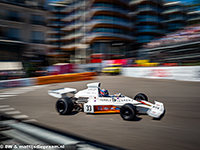 |
Why?
With two wins from two starts, Stuart Hall crowned himself the street prince of Monaco in the 2024 edition of the Monaco Grand Prix Historique, as the British pro driver bagged the spoils in the 1973-’76 and 1981-’85 F1 races while at the helm of the Rofgo Collection’s McLaren M23 and March 821. Besides Hall, Michael Lyons and Andy Middlehurst returned to their winning ways at Monaco, while Max Smith-Hilliard laid claim to being the true star of the meeting by rebounding from a fluffed start to claim an astonishing sportscar victory on the final lap.
As always in the streets of Monaco, several impatient drivers failed to keep their powder dry during free practice and qualifying, as no session went by without incident, with some eye-watering damage as a result. The biggest dramas occurred for Bruno Ferrari's March 701, the car with which Ronnie Peterson made his F1 debut at Monaco in 1970, and Sam Hancock’s freshly restored Fittipaldi F8. Yutaka Toriba's Wolf-Williams FW05, Philippe Bonny's Brabham BT2 and Julian Ellison's unique South African Assegai-Alfa Romeo also failed to proceed beyond qualifying due to the extensive damage that their cars had suffered.
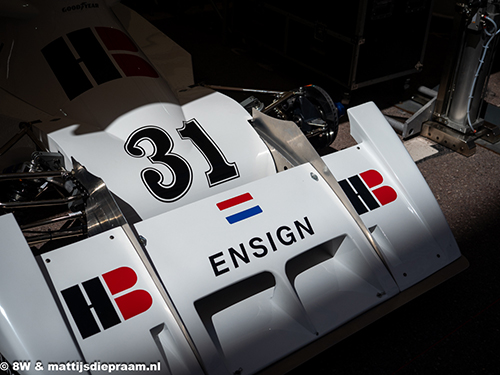
Marco Fumagalli debuted the recently restored Ensign N174 that was raced in period by Vern Schuppan, Roelof Wunderink and Gijs van Lennep. (photo 8W)
Sunday’s eight races themselves combined into a bewildering collection of straightforward lights-to-flag wins on the one hand and chaotic wreckfests on the other hand. Between the two extremes sat the 1950s sports car race, which would become the jewel of the event – following a poor getaway, Max Smith-Hilliard worked his way to the front, taking the lead on the final lap. That was certainly one to watch, despite the returning noises of Monaco Grand Prix Historique fans who would dearly love to see the return of the F3 race that until the last few editions of the event was a permanent and popular fixture on the programme.
Race day opened with the Série A2 race for front-engined pre-61 Grand Prix cars that saw start-to-finish dominance by German lady racer Claudia Hürtgen in the Team Methusalem-run Ferrari 246 Dino. She proved so effective at the wheel of the last front-engined Ferrari F1 car that her nearest rival, Marino Franchitti’s Maserati 250F, crossed the line some 15 seconds later. Meanwhile, the battle for third place attracted slightly more attention. Initially led by Joaquin Folch-Rusinol in the Lotus-Climax 16, Guillermo Fierro’s 250F and Tony Wood’s Tec-Mec fought tooth and nail over fourth right in the Catalan’s trail, with John Spiers keeping a watching brief in another 250F. Soon, though, Fierro was hot on the heels of Folch who subsequently not only lost the place to his compatriot but also spun out of the race on the approach to Rascasse. However, it was Wood who came away with the final podium spot after the Briton managed to pass Fierro on the final lap.

Kurt Delbene was back in the BRM-engined BRP Mk1 in its British GP guise. (photo 8W)
The subsequent race for pre-war Grand Prix cars and voiturettes followed a somewhat similar course. From pole, Paddins Dowling in the famous ERA R5B chassis nicknamed ‘Remus’ seemed to be on his way to yet another unchallenged victory at Monaco, helped by Michael Birch who managed to wriggle his Maserati 4CM in front of Brad Baker’s ERA B-type. Baker needed several laps to deal with Birch who could no longer offer any resistance when he seemed to miss a gear on the climb to Massenet. Then the Canadian rapidly closed in on Dowling, so for a moment we had a race on our hands. But apparently, Dowling had been in cruise mode up until then because as soon as the Irishman saw was given the warning that the other ERA was in hot pursuit, he pressed on once more in Prince Bira’s former race car to win by 14 seconds. Birch still managed to get his ailing Maserati across the line in third.
The race for Grand Prix cars from the 1.5-litre era was once again dominated by the two rivals who have been calling the shots in this race for years, as Andy Middlehurst started from the front in the famous ex-Jim Clark Lotus 25/R4 and needless to say that Joe Colasacco was in the hunt in the Ferrari 1512 right from the start. For laps, the American tried to find a way past the Lotus, before halfway through the race a backmarker seemed to have put an end to his attack. Yet Colasacco refused to give up, as he cranked out a series of fastest laps of the race from the miniature cylinders in the Ferrari until Middlehurst saw plenty of red in his mirrors again. The Briton failed to crack under pressure and as result notched up yet another big win at Monaco. Mark Shaw in his Lotus 21 finished third by a long way.
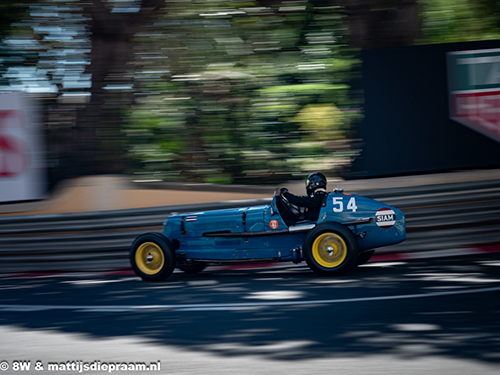
Once again, Paddins Dowling ruled in 'Remus', the famous ERA B-type that was raced in period by Prince Bira.
(photo 8W)
Then it was the turn of the first of four races for F1 cars from the 3-litre era. The 1966-‘72 period has been a difficult era in the regular Masters championship for many years, a fact that has now also translated to Monaco. The race saw a poor entry that became even poorer when several cars failed to survive the pre-grid and warm-up lap. Immediately after the start, Michael Lyons took off like a scolded cat in the Surtees TS9 as he headed for a renewed win in this category, but after eight laps he suddenly seemed to suffer with a steering issue. A problem with either the column or the rack made the car no longer wanting to go in the right direction, and Katsu Kubota in the Lotus 72 was rapidly approaching on the way to Rascasse. Lyons kept his presence of mind and angled his car to the right straight after the corner, at least not to bother the Japanese driver. The latter then drove on to an unchallenged victory.
That should have been Matt Wrigley’s, but outbraking himself into Ste Devote lost him precious time and allowed Kubota to zoom past his March 721G. Wrigley still finished second, though. Franco Meiners was on his way to third in the unique Ferrari 312B3 ‘Spazzaneve’ but in the mutual battle of the twelve-pots ‘Mr John of B’ in the Matra MS120C came through in the end, before Monegasque Meiners also spun away fourth place. This went to Adrian Newey, the parting Red Bull Racing tech chief who stayed out of trouble in his ex-Jim Clark Lotus 49B and caused a stir with a shrewd overtaking move out of the Fairmont hairpin, passing Nicolas Matile’s Matra MS120B on the outside towards Portiers.
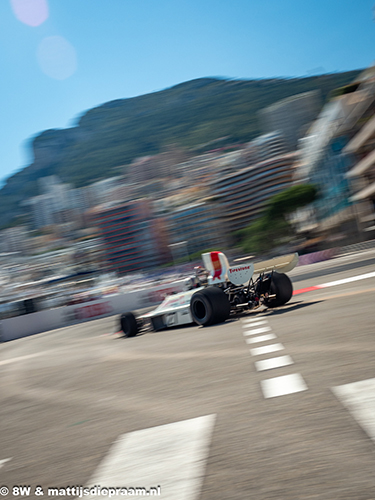
Steve Brooks attacking the chicane in the Embassy Hill GH1. (photo 8W)
The 1973-'76 F1 race was again as straightforward as the two opening races. In the Yardley McLaren M23 from the Rofgo Collection, Stuart Hall proved unbeatable, as in practice already it was easy to see Hall’s calmness in the car compared to his hard-working opponents Nick Padmore (Lotus 77), Marco Werner (Lotus 76) and Michael Lyons (in an early McLaren M26). From those three, Werner initially led the chase, but when the German was forced to retire from the race, it was up to Padmore and Lyons to keep Hall honest. Lyons eventually lost ground on his compatriot to finish a distant third.
After the break, the crowd was treated to the finest race of the day. Richard Wilson took the lead at the start, but after two laps his Maserati 250S was passed by Fred Wakeman who in his Cooper-Jaguar T38 pulled off the best move of the weekend – around the outside at Massenet to leave an astonished Wilson gasping for air. After that, it seemed a done deal for the American, but Max Smith-Hilliard was having none of that. In his Lotus MkX, the Briton was so fully pumped after messing up his start from the second row that even Wakeman was unable to resist. Four laps into the race, MSH was back up to fourth before he outsmarted Claudia Hürtgen in the Maserati 300S and then forced Wilson into a mistake at Casino. After that, Smith-Hilliard closed the gap to Wakeman who was obliged to pick some extremely defensive lines to keep his rival at bay. He did so too in the hairpin on the final lap after which the Cooper was unable to develop the pace needed to stay ahead into Portiers, allowing Smith-Hilliard to put his Lotus alongside. Wakeman tried to stay with the Lotus but going offline on the outside put the Cooper into a spin that gave Hürtgen second place and handed third to Niklas Halusa’s Jaguar D-type.

Tom Hartley Jnr exiting the tunnel in the ex-Jackie Stewart Tyrrell Racing Organisation March 701. (photo 8W)
The weekend ended with the two remaining F1 races for the 1977-‘80 and 1981-‘85 eras. The first race turned into a farce that amassed a total of six starts and no less than six laps under green. The race got under a bad omen as soon as Wayne Taylor (Wolf WR4) and Harald Becker (Arrows A3) connected at the start, as the experienced multiple IMSA champion from South Africa thought he had blitzed Becker and was looking to pass more cars straight away when he found out that the German was still on his inside when his car was slammed hard into the barriers on the left. Then, further down the lap, Stephen Shanley’s Tyrrell 010 swapped ends at the swimming pool, as a consequence dropping from third to 23rd place. First the safety car was sent out, but the red flag followed after two laps.
Cleaning up the mess on the straight took over half an hour, during which McLaren boss Zak Brown decided to park his Williams FW07B under the watchful eye of his F1 driver and fresh Grand Prix winner Lando Norris. More trouble was up, however, as the first restart turned into a shambles as Shanly’s car – apparently without anyone from the organisers noticing – had taken up its original third starting spot as the cars lined up in the pits. That was a mistake since the red flag was waved after the opening lap was completed. On the grid, this left no room for Mark Hazell to line up his FW07B in its rightful spot. Another dozen minutes were needed to then establish the correct starting order, but the second restart proved to be equally ill-fated, as Mike Cantillon's Tyrrell 010 and Luciano Biamino's Shadow DN8 stalled on the grid, forcing the start to be aborted.
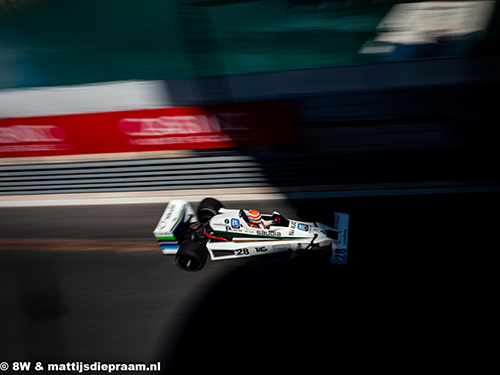
David Shaw proved unlucky in both the Eifelland Typ 21 and the Williams FW06. (photo 8W)
At the third attempt, the field got away, but on the opening lap of the race been shortened from 18 to 15 laps, events took yet another wrong turn, as Martin Overington tried to go side-by-side through the tunnel but once he was on the dust besides the racing line, his Hesketh 308E inevitably slid into the crash barriers. Overington climbed out on his own steam but ambulance staff wanted to check on his health anyway. In the previous stoppages, the race clock had always stopped, but this time it was decided to run down the clock while the debris was cleared. For the race’s fourth restart, it was decided to have a 10-lap race with a maximum duration of 30 minutes. But that too went wrong, as once again a car was found to be misaligned on the grid, David Shaw’s Williams FW06 this time. The race director then wisely decided to cut his losses and use a rolling restart from behind the safety to send the field on its way.
Five laps passed before the next violent crash put the race out of its misery, as Nicolas Matile stuck his March 771 into the wall at Tabac. The subsequent red flag was converted into a result on the spot. The win went to Michael Lyons in the Hesketh 308E who had held managed to hold off Miles Griffiths' Fittipaldi F5A. Another Fittipaldi, Jonathan Cochet’s F6A, was third.
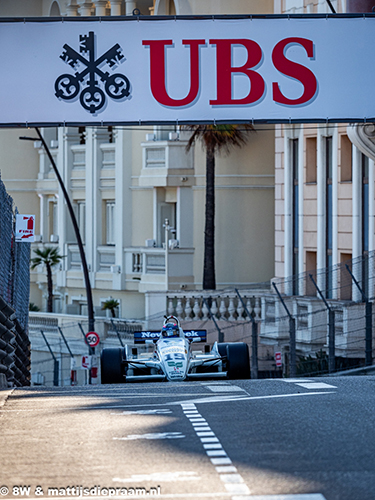
There was no stopping Stuart Hall in the March 821. (photo 8W)
More than an hour late, the final race of the day was about to go underway but it lasted even longer before we could get going as Prince Albert insisted on his customary gridwalk with his family and guests – and why not, since it’s his country! In that final race, the safety car was forced to come out again when Steve Hartley's Arrows A6 was brushed into the barrier at the entry to the chicane, but this time around, the race was able to continue for the full 18 laps. However, this failed to make the race any less chaotic, as almost half of the field retired through crashes or mechanical failures. Many drivers managed to interlock wheels, as Mark Higson drove his McLaren MP4/1B into the back of backmarker Piero Lottini who on the main straight remained undecided on which side of the track he was going to make way for the McLaren, Mike Cantillon damaged his Williams FW07C’s left front suspension through contact with Ken Tyrrell’s Tyrrell 011 at Mirabeau, while Jamie Constable smashed his 011 into Mark Hazell’s FW08B at the same spot in what looked like a similar racing incident somewhere in between ‘He turned in on me!’ and ‘You can’t overtake there!’.
Once again, Stuart Hall reigned effortlessly in this race. His March 821 – an underwhelming design at the time – kept Marco Werner’s Lotus 87B and Michael Lyons’ Lotus 92 at bay while his third pursuer, Nick Padmore’s twin-chassis Lotus 88B, was forced out prematurely. This allowed Marino Franchitti to finish fourth in the ex-Stefan Bellof Tyrrell 012.
